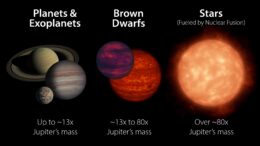In astronomy, seeing isn’t always believing, and extra checks are required to make sure we don’t fool ourselves into oversimplifying nature. With the help of citizen scientists, a team of astronomers recently illustrated the value of such thoroughness and demonstrated that three previously observed fuzzy blobs may actually be rare, close-in pairs of brown dwarfs.
Point Sources Confusion

A comparison of the size of planets, brown dwarfs, and stars. Click to enlarge. [NASA/JPL-Caltech]
This means that what looks like one small, fuzzy blob can actually be two stars packed tightly together, both so far away from Earth that their images are blurred together into one. In rare but exciting cases, these blobs don’t correspond to stars at all, and instead are actually images of one or more brown dwarfs. These objects have masses that fall between stars and planets, and a more complete understanding of their formation would enable better models of both their bigger and smaller cousins. Binaries, or pairs of these objects orbiting each other, are especially useful since long-term radial velocity studies can reveal the masses of each constituent. Astronomers know of only a handful of brown dwarf binaries, so each discovery of a new pair, or even evidence that a given blob might be a pair, is cause for excitement.
WISE Citizens

The WISE telescope prior to its launch in 2009 from Vandenberg Air Force Base, California. WISE was placed in hibernation in 2011 but reawakened in 2013 to hunt for near-earth objects. [NASA/JPL-Caltech]
Bravo and collaborators used the in Chile to collect the spectrum of each target, then compared these to spectra of previously confirmed brown dwarfs. In a happy surprise, none of the “templates” fit their new data very well. These objects were strange: at some wavelengths, they looked like a certain type of large brown dwarf, while at others, they looked like a much smaller and cooler variant.

Data and best-fitting models for one of the three candidates. The top panel shows the data (black) and best-fitting model (red) assuming the spectrum is composed of only one brown dwarf. The bottom panel shows how the same data are better matched by a model that allows for a pair of objects. Click to enlarge. [Adapted from Bravo et al. 2023]
Citation
“An Investigation of New Brown Dwarf Spectral Binary Candidates From the Backyard Worlds: Planet 9 Citizen Science Initiative,” Alexia Bravo et al 2023 AJ 166 226. doi:10.3847/1538-3881/acffc1
